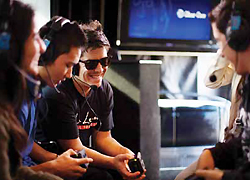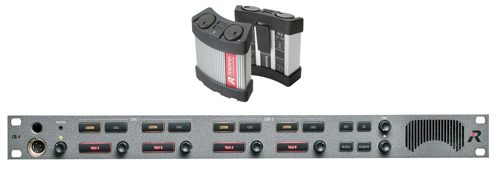In an earlier time, rural telephone systems effectively connected everyone along the road into a single communications link, dubbed a “party-line.” By the late 1960s, both Clear-Com and RTS independently adopted the same basic concept with the development of the party-line intercom.
Individual beltpack-style intercom stations interconnected with microphone cables allowed the production’s technical staff to call cues and otherwise collaborate in a full-duplex manner throughout the venue – all on one channel.
As the need arose, main stations that accessed two or four channels permitted directors to be more targeted in their communications to the technical staff, and 2-channel beltpacks were developed for some personnel.
Yet direct person-to-person communication and flexible channel assignments from a beltpack remained an elusive dream for additional decades; it would take the mainstream development of personal computers, networking, cellular communications, and digital audio processing to provide the technology that would make the dream a reality.
Traditional Party-Line
A standard party-line intercom system still consists of 2- or sometimes 4-channel main stations for director positions that provide the connections and the DC power supplies to attach and run the beltpacks, which are typically daisy-chained or connected with a “Y” splitter to create different legs of the same communication channel. Beltpacks have momentary/latching talk buttons so that production staff can reply and discuss, and the listen is always on.
The systems get the job done, but have limitations – especially for complex productions where an individual might benefit from access to both group and private conversations. The wiring is one microphone cable per channel, and the physical layout of the cables is time-consuming to change on the fly, requiring different cable runs. Limitations on total cable length within a system before the signal degrades significantly leads to capacity restraints.
Adding a new position on a particular party-line means more rewiring. As a side note, the digital matrix intercom systems developed in the early 1990s and mainly used in broadcast production gave users the ability to access various group and private conversations, but the station was typically a rack-mount unit with multiple keys, and was not practical for a stage tech that needed to be mobile or a lighting guy on the catwalk. The question was how to bring a subset of that flexibility to the beltpack.
Advent Of Digital
The relatively new digital party-line systems have broken through the technical hurdles, and can deliver multiple, selectable channels of communication via a single cable to the beltpack. Variations on this technology are available from Riedel Communications and Clear-Com.
The Riedel Performer is the first digital party-line system to be commercially available. It offers 2- and 4-channel master stations with 2-channel beltpacks. Wall-mount and desktop speaker stations are also available. Intercom expert Dave Brand, who helped introduce Riedel in the U.S., characterizes the Performer’s audio quality as excellent, extremely quiet and with no latency issues. The system uses “a modified AES bit stream.”
For best results, Riedel recommends using AES/EBU 110-ohm twisted-pair XLR cables rather than standard mic cable. The maximum recommended distance between connected beltpacks is 300 meters (more than 900 feet), though the entire party-line can have up to 2.5 kilometers of cable.
















